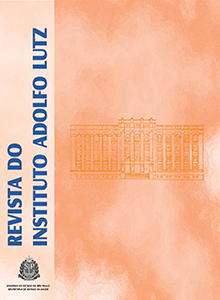Evaluation of the “shelf life” of nitrocellulose membranes immobilized with Paracoccidioides brasiliensis antigen for performing the immunodiagnosis of paracoccidioidomycosis
Abstract
The immunoblotting reaction for performing the paracoccidioidomycosis (PCM) immunodiagnosis is an in-house methodology; and being a laborious task involving two previous steps, SDS-PAGE and Western blot, we evaluated the shelf life of nitrocellulose membranes containing the immobilized P. brasiliensis antigens, stored at -20 o C for 7, 15, 30, 45, 60 and 90 days. Twenty-eight serum samples were analyzed on two nitrocellulose membranes groups: (a) membranes previously blocked with PBS-5 % non-fat dry milk and (b) the priory non-blocked membranes. No difference was detected in the reactivity pattern in serum samples evaluated in the both membrane groups, especially for those stored for 7, 15, 30, 45 and 60 days. It might be emphasized that a good stability of P. brasiliensis antigens, immobilized on the nitrocellulose membranes, enable them to be stored up to 60 days at -20 o C. This finding contributes to the rapid diagnosis of PCM, and for sending them to other laboratories without adequate infrastructure for carrying out the steps that precede the immunodetection as the antigen production, SDS-PAGE and Western blot techniques. This scheme contributes substantially to improve the quality of PCM serodiagnosis, as it provides reproducible results in the units of the Laboratory Network.References
Colombo AL, Tobón A, Restrepo A, Queiroz-Telles F, Nucci M. Epidemiology of endemic systemic fungal infections in Latin America. Med Mycol 2011;49(8):785-98. [DOI: http://dx.doi.org/10.3109/1 3693786.2011.577821].
Gonzalez A, Hernandez O. New insights into a complex fungal pathogen: the case of Paracoccidioides spp. Yeast. 2016;33(4):113-28.[DOI: http:/dx.doi.org/10.1002/yea.3147].
De Oliveira HC, Assato PA, Marcos CM, Scorzoni L, de Paula E Silva AC, Da Silva J de F et al. Paracoccidioides-host Interaction: An Overview on Recent Advances in the Paracoccidioidomycosis. Front Microbiol. 2015;25 (6):1319 [DOI: http:dx.doi. org/10.3389/fmicb.2015.01319].
Seyedmousavi S, Guillot J, Tolooe A, Verweij PE, de Hoog GS. Neglected fungal zoonoses: hidden threats to man and animals. Clin Microbiol Infect. 2015;21(5):416-25. [DOI: http:dx.doi.org/10.1016/j.
cmi. 2015.02.031].
Teixeira MM, Theodoro RC, Oliveira FF, Machado GC, Hahn RC, Bagagli E et al. Paracoccidioides lutzii sp. nov.: biological and clinical implications. Med Mycol. 2014; 52(1):19-28. [DOI: http:/dx.doi.org /10.3109/13693786.2013.794311].
Martinez R. Epidemiology of paracoccidioidomycosis. Rev Inst Med Trop Sao Paulo. 2015;57 Suppl 19:11-20. [DOI: http:/dx.doi.org/ 10.1590/S0036-46652015000700004].
Martinez R. Paracoccidioidomycosis: the dimension of the problem of a neglected disease. Rev Soc Bras Med Trop. 2010;43(4):480. [DOI: http:/
dx. doi.org/10.1590/S0037-86822010000400034].
Teles FR, Martins ML. Laboratorial diagnosis of paracoccidioidomycosis and new insights for the future of fungal diagnosis. Talanta. 2011;85(5):2254-64.[DOI: http:/dx.doi.org/10.1016/j.talanta.2011.07.099].
Silva Ferreira C, de Castro Ribeiro EM, Miranda Goes AD, Mello Silva B. Current strategies for diagnosis of paracoccidioidomycosis and prospects of methods based on gold nanoparticles. Future Microbiol. 2016;11:973-85. [DOI: http:/dx.doi.org/10.2217/fmb-2016-0062].
De Camargo ZP. Serology of paracoccidioidomycosis. Mycopathologia. 2008;165:289-302.
da Silva JF, de Oliveira HC, Marcos CM, Assato PA, Fusco-Almeida AM, Mendes-Giannini MJ. Advances and challenges in paracoccidioidomycosis serology caused by Paracoccidioides species complex: an update. Diagn Microbiol Infect Dis. 2016;84(1):87-94.[DOI:http:/dx.doi.org/10.1016/j.diagmicrobio. 2015.06.004].
Fernandes VC, Coutinho JB, Veloso JM, Araújo AS, Pedroso EP, Goes AM. Combined use of Paracoccidioides brasiliensis recombinant rPb27 and rPb40 antigens in an enzyme-linked immunosorbent assay for immunodiagnosis of paracoccidoidomycosis. J Immunol Methods. 2011;367(1-2):78-84. [DOI: http:/dx.doi.org/10.1016/j.jim.2011.02.006].
Silva DF, Assis CM, Zamboni IM, Barreto LC, Kohara VS, Vicentini-Moreira AP. Use of immunoblotting assay improves the sensitivity of paracoccidioidomycosis diagnosis. J Venom Anim Toxins incl Trop Dis. 2008;14(2):313-21.
Perenha-Viana MC, Gonzales IA, Brockelt SR, Machado LN, Svidzinski TI. Serological diagnosis of paracoccidioidomycosis through Western blot technique. Clin Vaccine Immunol. 2012;19:616-9.[DOI: http:/dx.doi.org/10.1128/CVI.05693-11].
Passos AN, Kohara VS, Moreto TC, Mendes RP, Kamikawa CM, Vicentini AP. Analysis of the intrinsic parameters of double immunodiffusion and immunoblotting assays for the paracoccidioidomycosis diagnosis. XI International Meeting on Paracoccidioidomycosis; São Paulo; May 2011 [abstract 45-6].
Passos AN. Avaliação da aplicabilidade da técnica de immunoblotting para a pesquisa de anticorpos circulantes anti-Paracoccidioides brasiliensis e anti-Histoplasma capsulatum em laboratório de Saúde Pública [dissertação de mestrado]. São Paulo (SP): Coordenadoria de Controle de Doenças; 2012.
Silveira-Gomes F, Sarmento DN, Pinto TM, Pimentel RF, Nepomuceno LB, Espirito Santo EP, et al. Development and evaluation of latex agglutination test for the serodiagnosis of paracoccidioidomycosis. Clin Vaccine Immunol. 2011;18(4):604-8. [DOI: http:/dx.doi.org/10.1128/CVI.00130-10].
Kamikawa CM, Vicentini AP. Dot-blot methodology for rapid diagnosis of paracoccidioidomycosis caused by Paracoccidioides brasiliensis. J Infect Dis Ther. 2015; 3(6). [DOI: http:/dx.doi.org/10.4172/2332-0877.1000256].
Neves AR, Manomi RL, Rossi CL, Camargo ZP, Blotta MH. Negative immunodiffusion test results obtained with sera of paracoccidioidomycosis patients may be related to low-affinity immunoglobulin G2 antibodies directed against carbohydrate epitopes. Clin Diagn Lab Immunol. 2003;10(5):802-7. [DOI: http:/dx.doi.org/ 10.1128/CDLI.10.5.802-807.2003].
Do Valle AC, Costa RL, Fialho Monteiro PC, Von Helder J., Muniz MM., Zancopé-Oliveira RM. Interpretation and clinical correlation of serological tests in paracoccidioidomycosis. Med Mycol. 2001;39:373-7.
Kirkwood TB. Predicting the stability of biological standards and products. Biometrics. 1977;33(4):736-42.
Garcia NM, Assis CM, Del Negro GMB, Aguiar MSMV, Lacaz CS. Análise imunoquímica de antígeno metabólico de P. brasiliensis. Rev Inst Med Trop São Paulo. 1993;35(suppl.10):70.
Laemmli UK. Cleavage of structural proteins during the assembly o the head of bacteriophage T4. Nature. 1970;227(5259):680-5.
Towbin H, Staehelin T, Gordon J. Electrophoretic transfer of proteins from polyacrylamide gels to nitrocellulose sheets: procedure and some applications. Proc Natl Acad Sci USA. 1979;76(9):4350-4.










